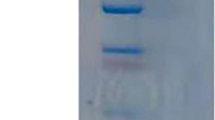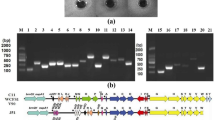Abstract
Pediocin PA-1, mainly produced from Pediococcus spp., is a well-known class IIa bacteriocin showing strong anti-listerial activity. Pediococcus acidilactici K10 producing the bacteriocin was transformed with pLR5cat(S)_PSAB in which the pediocin PA-1 structural gene (pedA) was translationally fused with a deduced signal sequence of the bifidobacterial α-amylase gene for secretion. The P. acidilactici K10 transformant presented increased bacteriocin activity when compared with that of native P. acidilactici K10. The P. acidilactici K10 mutant (K10M), in which the plasmid for pediocin PA-1 production is cured, also showed bacteriocin activity when transformed with pLR5cat(S)_PSAB, indicating that the pediocin gene was expressed in hosts. An increase in pedA gene transcription level and the detection of both transcripts from the pediocin operon and PSAB were also confirmed. The P. acidilactici K10 [pLR5cat(S)_PSAB] transformant was more inhibitory against Listeria monocytogenes than that of the P. acidilactici K10 wild type in co-cultures.
Similar content being viewed by others
References
Dal Bello B, Cocolin L, Zeppa G, Field D, Cotter PD, Hill C. Technological characterization of bacteriocin producing Lactococcus lactis strains employed to control Listeria monocytogenes in cottage cheese. Int. J. Food Microbiol. 153: 58–65 (2012)
Scholl D, Gebhart D, Williams SR, Bates A, Mandrell R. Genome sequence of E. coli O104:H4 leads to rapid development of a targeted antimicrobial agent against this emerging pathogen. PLoS ONE 7: e33637 (2012)
Chang JY, Chang HC. Growth inhibition of foodborne pathogens by kimchi prepared with bacteriocin-producing starter culture. J. Food Sci. 76: M72–M78 (2011)
van Heel AJ, Montalban-Lopez M, Kuipers OP. Evaluating the feasibility of lantibiotics as an alternative therapy against bacterial infections in humans. Expert Opin. Drug Met. 7: 675–680 (2011)
De Vuyst L, Leroy F. Bacteriocins from lactic acid bacteria: Production, purification, and food applications. J. Mol. Microb. Biotech. 13: 194–199 (2007)
Mitra S, Mukhopadhyay BC, Biswas SR. Potential application of the nisin Z preparation of Lactococcus lactis W8 in preservation of milk. Lett. Appl. Microbiol. 53: 98–105 (2011)
Héchard Y, Sahl H. Mode of action of modified and unmodified bacteriocins from Gram-positive bacteria. Biochimie 84: 545–557 (2002)
Papagianni M, Anastasiadou S. Pediocins: The bacteriocins of Pediococci. Sources, production, properties, and applications. Microb. Cell Fact. 8:3 (2009)
Rodríguez JM, Martínez MI, Kok J. Pediocin PA-1, a widespectrum bacteriocin from lactic acid bacteria. Crit. Rev. Food Sci. 42: 91–121 (2002)
Eom JE, Moon SK, Moon GS. Heterologous production of pediocin PA-1 in Lactobacillus reuteri. J. Microbiol. Biotechn. 20: 1215–1218 (2010)
Moon GS, Pyun YR, Park MS, Ji GE, Kim WJ. Secretion of recombinant pediocin PA-1 by Bifidobacterium longum, using the signal sequence for bifidobacterial α-amylase. Appl. Environ. Microb. 71: 5630–5632 (2005)
Beaulieu L, Tolkatchev D, Jetté JF, Groleau D, Subirade M. Production of active pediocin PA-1 in Escherichia coli using a thioredoxin gene fusion expression approach: Cloning, expression, purification, and characterization. Can. J. Microbiol. 53: 1246–1258 (2007)
Schoeman H, Vivier MA, du Toit M, Dicks LMT, Pretorius IS. The development of bactericidal yeast strains by expressing the Pediococcus acidilactici pediocin gene (pedA) in Saccharomyces cerevisiae. Yeast 15: 647–656 (1999)
Chikindas ML, Venema K, Ledeboer AM, Venema G, Kok J. Expression of lactococcin A and pediocin PA-1 in heterologous hosts. Lett. Appl. Microbiol. 21: 183–189 (1995)
Reviriego C, Fernández L, Rodríguez JM. A food-grade system for production of pediocin PA-1 in nisin-producing and non-nisinproducing Lactococcus lactis strains: Application to inhibit Listeria growth in a cheese model system. J. Food Protect. 70: 2512–2517 (2007)
Moon GS, Pyun YR, Kim WJ. Characterization of pediocin operon of Pediococcus acidilactici K10 and expression of His-tagged recombinant pediocin PA-1 in Escherichia coli. J. Microbiol. Biotechn. 15: 403–411 (2005)
Kwon DY, Koo M, Ryoo CR, Kang CH, Min KH, Kim WJ. Bacteriocin produced by Pediococcus sp. in kimchi and its characteristics. J. Microbiol. Biotechn. 12: 96–105 (2002)
Moon GS, Lee YD, Kim WJ. Screening of a novel lactobacilli replicon from plasmids of Lactobacillus reuteri KCTC 3678. Food Sci. Biotechnol. 17: 438–441 (2008)
Ray B, Daeschel M. Food Biopreservatives of Microbial Origin. CRC Press, Boca Raton, FL, USA. pp. 64–70 (1992)
Author information
Authors and Affiliations
Corresponding author
Rights and permissions
About this article
Cite this article
Eom, JE., Park, JY. & Moon, GS. Increased bacteriocin activity of a recombinant Pediococcus acidilactici . Food Sci Biotechnol 21, 1781–1784 (2012). https://doi.org/10.1007/s10068-012-0238-3
Received:
Revised:
Accepted:
Published:
Issue Date:
DOI: https://doi.org/10.1007/s10068-012-0238-3




